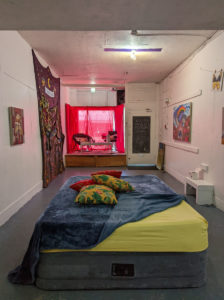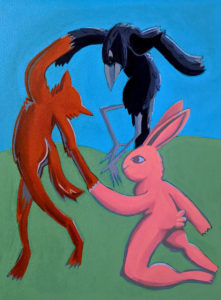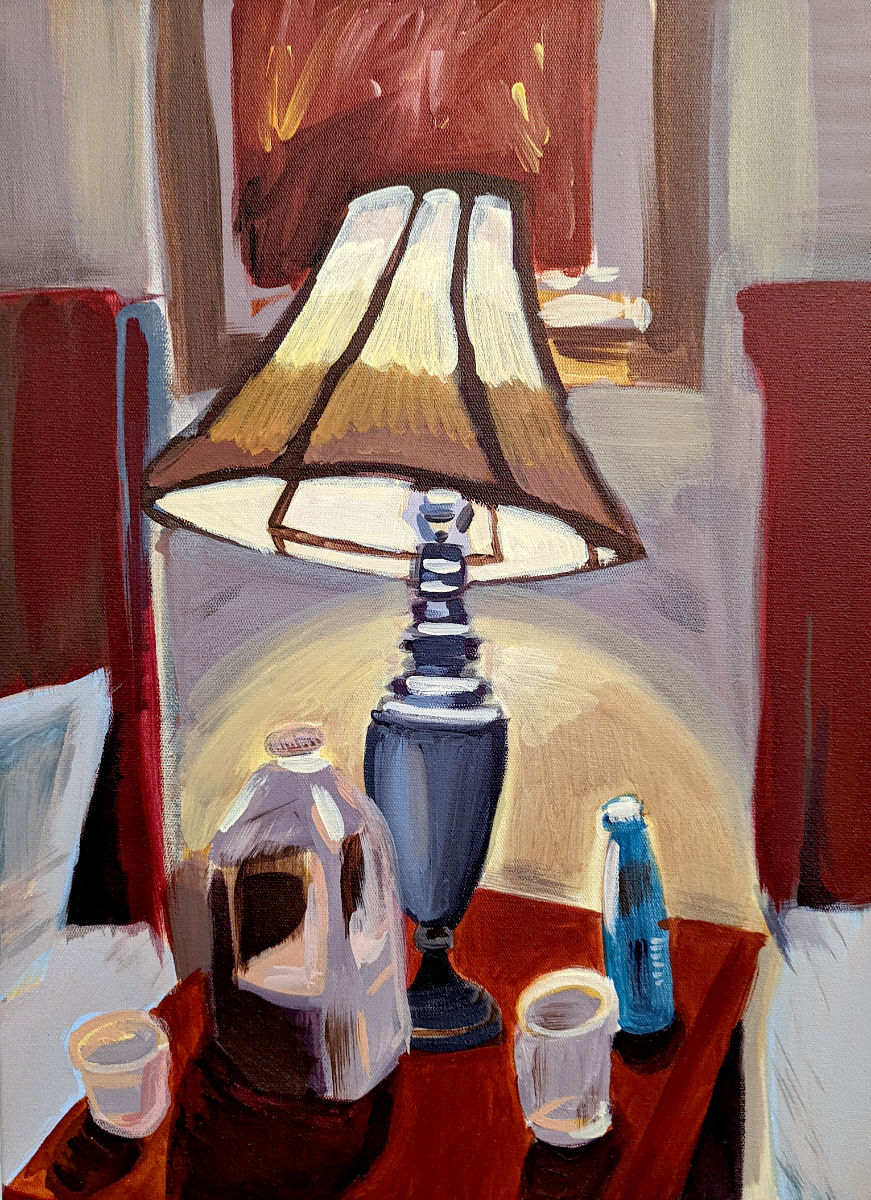I walked right past The JAM Studios at first. A storefront hidden by red curtains in the window, with only a hand-drawn sign, embellished with tiny hearts, to draw me inside. The space was what one might expect from an artist collective: modest, but well used. Paintings plastered the white walls while a full-sized bed packed with pillows and fuzzy blankets rested at the centre. As I was ruminating on the state of handshakes, artist Vee CR caught my eye. I introduced myself briefly, and before I could thrust out an uncertain hand, I found their arms around me in a hug. I couldn’t remember the last time I hugged a stranger. From that moment on, I knew I was a welcomed observer of Vee’s inner world. One of many looking in on their solo show, What is Love?
I was guided through the intimate chamber by Vee, who spoke of their work in terms of love, grief, and queerness. I was immediately drawn towards the biggest and most vibrant piece in the room — a ten-foot-tall painted tapestry depicting a multicoloured lion. A banner blazoned by winged cherubs floating atop it read “lioness,” which is also the title. Vee pointed out the lion’s mane to me: the beast is bearded despite its taxonomy. And as they discussed gender fluidity, I also noticed a layer of torn and tattered clothing underneath thick acrylic paint: tights, ties, and remnants of gendered undergarments dress the lioness, while underpinning the constructed nature of gender. With a cheeky nod to Christian symbolism, and a subtle reimagination of the typically female moon as an icon of fluidity — it is clear Vee likes to play with expectations.

Moving deeper into the exhibition, Vee’s work takes a more personal approach. A tryptic of still-life paintings asks the viewer to look at moments of love, loss, and transformation from Vee’s perspective. These scenes take on a photographic element, as everyday items are captured in the light of emotion. “The Night I Knew (toothbrushes)” grasps at the instant Vee realized they were in love. Something intimate about two toothbrushes, they recalled. A photo of Vee’s partner cuddling their pet bunny is translated into the work, “Madonna and Child,” a portrait encircled by tiny fake carrots, like offerings at an altar. Treating the intimate as sacred, Vee explores the power of love to transform the everyday into art. I was confronted with the private, yet universal nature of the sort of revelation Vee was getting at: although I may not understand the emotional significance of a lamp for the artist, we’ve all experienced a moment caught in time, when the banal is magnified, and given meaning through love, or grief.
Though sentimental, Vee is not afraid to explore the terrain of pleasure and queer sexuality in their work. “Birds and the Fur-bees (Self-Portrait) places the viewer in a dually inviting and threatening landscape, as a human-cat hybrid in lingerie entices the viewer in the foreground, while a massive snake-like furby lurks behind. A rainbow and celestial clouds welcome you to heaven, but it’s not what you expected. Vee called this the notion of (dis)pleasure: the element of discomfort and the unknown inherent in pleasure. Something about this piece was off-putting, but I couldn’t stop staring at it. The intrusion of a favourite childhood toy into this fantasy realm was successfully uncanny, if not terrifying.

I was guided to the back of the studio where a small painting was tucked away in the corner. In the style of Matisse’s “Dance,” three cartoonish animals are engaged in a jig, holding hands as they cycle through a movement. A contemplation of polyamorous love, I am told. But Vee directed me towards the arms of the figures, how they were attached to one another. A subtle difference: the rabbit and the dog are a part of each other, ever-connected in the dance, while the dog only reaches out towards the crow, beginning to engage with a new partner. Looking closer, I found that “Takes Three to Tango (Until Our Next Dance)” was about delicate dynamics, and the dance of love, more than numbers. And for Vee, love does not come without pain. Nestled in the same corner were three dried roses, collected in a vase and elevated on a white podium. A basic symbol, I thought, until Vee began to speak of the deceptive nature of beauty. Love is beautiful, but this means that sometimes we miss its deeper meaning, they explained. “Lyrics Lost in a Melody (3 Roses)” may have been lost on me without interpretation, but I couldn’t help but wonder what the roses were trying to tell me, behind their simple beauty.
Winding towards the heart of the room, we finally stopped at the bed. I was surprised to find a caption on the wall next to it: “A Place for intimate Conversation, 2022. Not for sale.” I chuckled, but then began to understand why it was there. Friends and family lounged on the bed, chatting in cozy comfort. I had a feeling the bed was brought from their home (it was), which seemed fitting for a show about intimacy, relationships, and love. Vee had revealed a part of themselves to me through their art — a part most people keep hidden. It was only right that the bed was hauled out of the private space and into the public, inviting viewers to engage in intimate conversation with each other and the work, putting themselves on display. A metaphor for the show itself, I thought. Vee put everything out in the open: the strange, the painful, and the beautiful parts of love.


